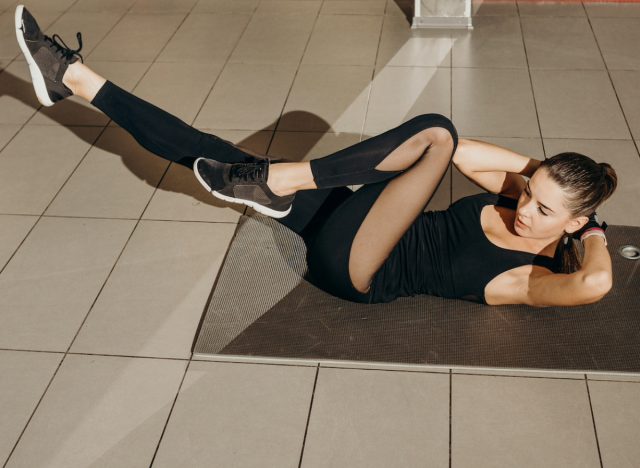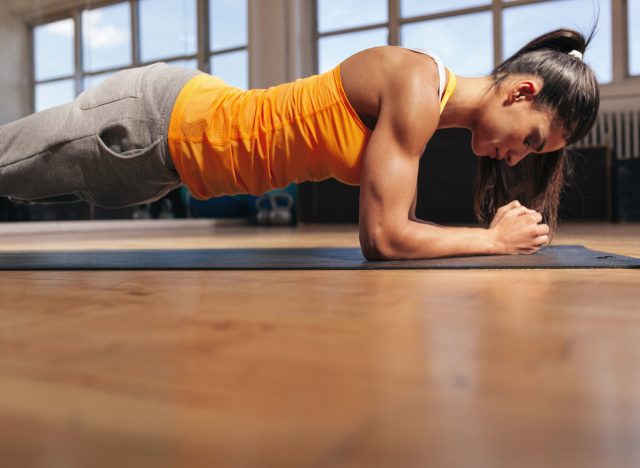Building and maintaining strong abs is important for many reasons. First off, they support your spine, which promotes good posture and a strong back. They also enhance your balance, workouts, and everyday activities. Needless to say, a solid six-pack not only looks great, but it will help your body function so much better. That being said, it’s important to know how many days a week you should focus on your abs to build a six-pack.
How Many Days a Week Should You Train Your Abs?


Plain and simple, you should strive to train your abs two to three times a week, making every workout count. Avoid falling into the pattern of working your abs five to seven days a week, as it will increase the time it takes to reach your goal.
“You shouldn’t treat ab training much differently than other muscles,” explains Domenic Angelino, CPT at International Personal Trainer Academy (IPTA). “Although [your] abs can recover a bit faster between workouts than most muscles, you still shouldn’t train them every day. If you train your abs too frequently, your workout intensity will lower, meaning that you’ll get less out of each individual ab workout.”
Angelino suggests using weights, if necessary, to step up the difficulty level as you progress.
What Are the Best Exercises for Six-Pack Abs?
Your exercise of choice may vary based on your body type.
If you have moderate or more body fat:
“If you are currently someone with a moderate to large amount of excess fat, focus on cardio,” Angelino recommends. “Then, focus on direct ab training once you are leaner.”
1. Swimming


Swimming is stellar when it comes to torching fat, which is beneficial when it comes to developing lean abs.
“One of the main benefits of swimming for someone who wants to have six-pack abs is that swimming also engages your abdominal muscles in a meaningful way, helping you build ab muscles while also helping with fat loss,” says Angelino.
2. Running


Running is a seamless and accessible method for those who want to burn fat and reveal their abs. In addition, you can do it pretty much anywhere.
“You can run on a treadmill at a gym or in your apartment. You can run on a track, in the woods, at a park, or around your neighborhood,” explains Angelino. “Running also involves your abdominal muscles.”
3. Outdoor Biking


Biking outdoors helps you melt body fat while firing up your abdominal muscles.
“When you bike outdoors, your abdominal muscles will help you stay balanced, keeping your body and the bike upright,” Angelino points out. “This effect won’t be present when using a stationary bike, so I’d recommend outdoor biking over indoor biking.”
If your body fat is less than moderate:
If you have a less-than-moderate amount of body fat, Angelino recommends direct ab training.
“The exercises below will help you comprehensively train all of the major muscle groups in your abdominal wall that you would care about if attempting to develop six-pack abs that pop,” he says. “Each [exercise] can also be modified to reflect your current [ability level].”
1. Hanging Leg Raises


Hanging leg raises can directly impact the size of your ab muscles. “[This exercise will] also strengthen your transverse abdominis muscle in a way that will help your six-pack abs pop a little more,” Angelino says.
If this exercise is too difficult, consider a lying leg raise.
2. Elbow to Knee Crunches


This crunch variation will help you build up your obliques, the outer area of your abs.
“Large obliques can make your six-pack look larger, since your bulky abdominal muscles will noticeably cover more of your torso,” Angelino explains. “This exercise is also great because it targets both your obliques and your rectus abdominis—the six-pack abs muscle—at the same time. And it trains both effectively.”
If you find this exercise too challenging, consider Russian twists or regular crunches.
3. Planks


You can’t beat a classic plank! This exercise is extremely effective when it comes to strengthening your transverse abdominis.
“Strengthening your transverse abdominis muscle [helps] keep your core stable during other heavy exercises, which will indirectly lead to you strengthening your abs while performing exercises like squatting,” Angelino explains. “If you can squat more weight, you will engage your abs a bit more when squatting to keep your body stable.”
If this exercise is too difficult, a kneeling plank is another option.









